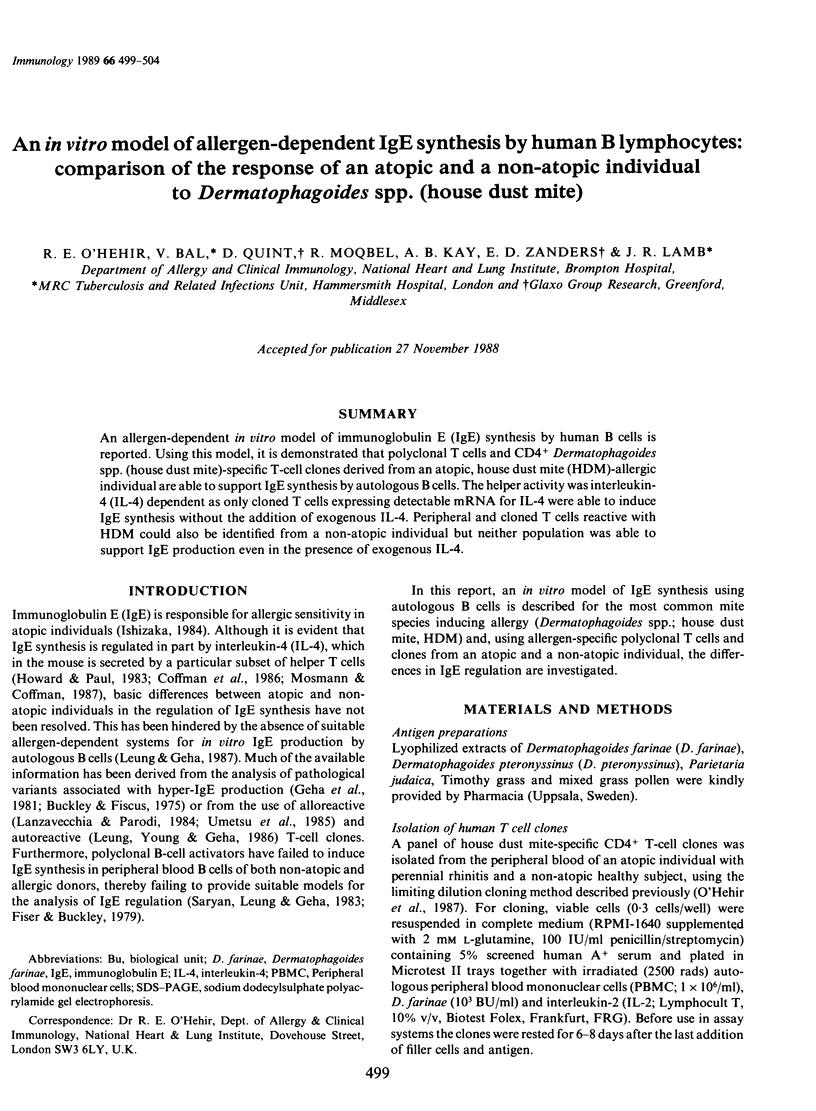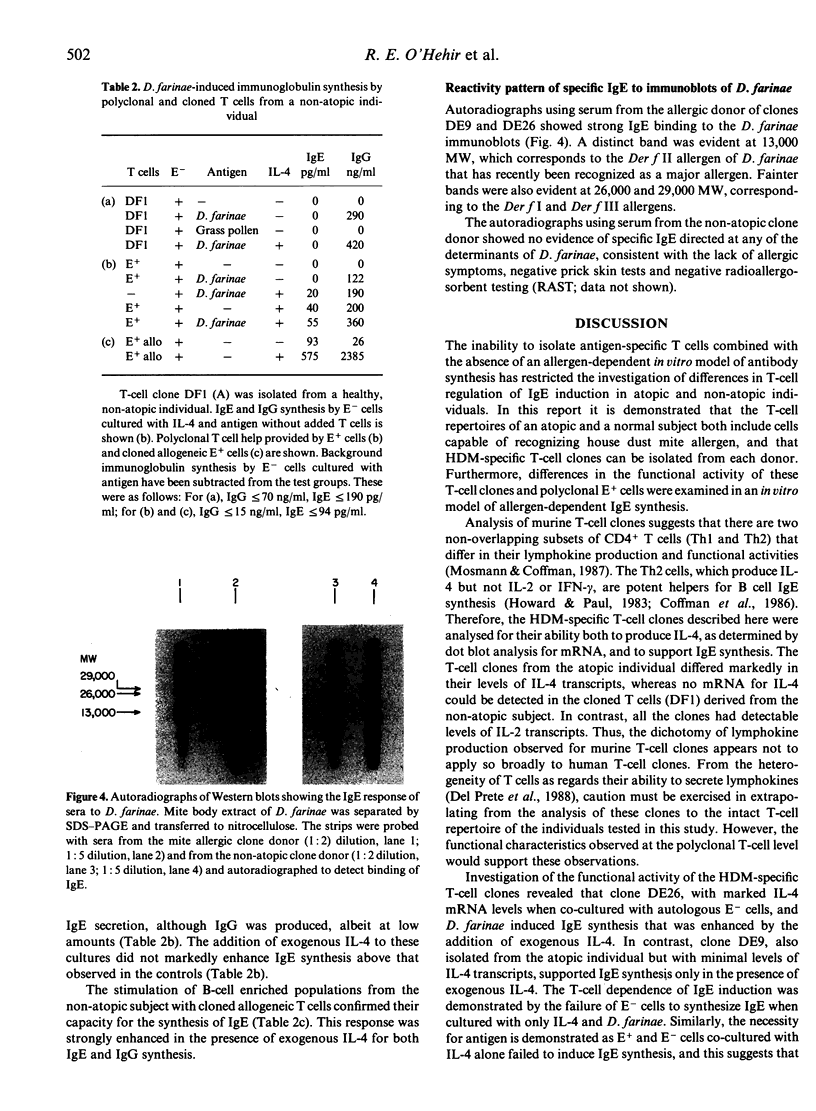Abstract
An allergen-dependent in vitro model of immunoglobulin E (IgE) synthesis by human B cells is reported. Using this model, it is demonstrated that polyclonal T cells and CD4+ Dermatophagoides spp. (house dust mite)-specific T-cell clones derived from an atopic, house dust mite (HDM)-allergic individual are able to support IgE synthesis by autologous B cells. The helper activity was interleukin-4 (IL-4) dependent as only cloned T cells expressing detectable mRNA for IL-4 were able to induce IgE synthesis without the addition of exogenous IL-4. Peripheral and cloned T cells reactive with HDM could also be identified from a non-atopic individual but neither population was able to support IgE production even in the presence of exogenous IL-4.
Full text
PDF





Images in this article
Selected References
These references are in PubMed. This may not be the complete list of references from this article.
- Adorini L., Harvey M. A., Miller A., Sercarz E. E. Fine specificity of regulatory T cells. II. Suppressor and helper T cells are induced by different regions of hen egg-white lysozyme in a genetically nonresponder mouse strain. J Exp Med. 1979 Aug 1;150(2):293–306. doi: 10.1084/jem.150.2.293. [DOI] [PMC free article] [PubMed] [Google Scholar]
- Bresser J., Doering J., Gillespie D. Quick-blot: selective mRNA or DNA immobilization from whole cells. DNA. 1983;2(3):243–254. doi: 10.1089/dna.1983.2.243. [DOI] [PubMed] [Google Scholar]
- Buckley R. H., Fiscus S. A. Serum IgD and IgE concentrations in immunodeficiency diseases. J Clin Invest. 1975 Jan;55(1):157–165. doi: 10.1172/JCI107906. [DOI] [PMC free article] [PubMed] [Google Scholar]
- Cebra J. J., Komisar J. L., Schweitzer P. A. CH isotype 'switching' during normal B-lymphocyte development. Annu Rev Immunol. 1984;2:493–548. doi: 10.1146/annurev.iy.02.040184.002425. [DOI] [PubMed] [Google Scholar]
- Coffman R. L., Carty J. A T cell activity that enhances polyclonal IgE production and its inhibition by interferon-gamma. J Immunol. 1986 Feb 1;136(3):949–954. [PubMed] [Google Scholar]
- Coffman R. L., Ohara J., Bond M. W., Carty J., Zlotnik A., Paul W. E. B cell stimulatory factor-1 enhances the IgE response of lipopolysaccharide-activated B cells. J Immunol. 1986 Jun 15;136(12):4538–4541. [PubMed] [Google Scholar]
- Del Prete G., Maggi E., Parronchi P., Chrétien I., Tiri A., Macchia D., Ricci M., Banchereau J., De Vries J., Romagnani S. IL-4 is an essential factor for the IgE synthesis induced in vitro by human T cell clones and their supernatants. J Immunol. 1988 Jun 15;140(12):4193–4198. [PubMed] [Google Scholar]
- Fiser P. M., Buckley R. H. Human IgE biosynthesis in vitro: studies with atopic and normal blood mononuclear cells and subpopulations. J Immunol. 1979 Oct;123(4):1788–1794. [PubMed] [Google Scholar]
- Gearhart P. J., Sigal N. H., Klinman N. R. Production of antibodies of identical idiotype but diverse immunoglobulin classes by cells derived from a single stimulated B cell. Proc Natl Acad Sci U S A. 1975 May;72(5):1707–1711. doi: 10.1073/pnas.72.5.1707. [DOI] [PMC free article] [PubMed] [Google Scholar]
- Geha R. S., Reinherz E., Leung D., McKee K. T., Jr, Schlossman S., Rosen F. S. Deficiency of suppressor T cells in the hyperimmunoglobulin E syndrome. J Clin Invest. 1981 Sep;68(3):783–791. doi: 10.1172/JCI110315. [DOI] [PMC free article] [PubMed] [Google Scholar]
- Halvorsen R., Bosnes V., Thorsby E. T cell responses to a Dermatophagoides farinae allergen preparation in allergics and healthy controls. Int Arch Allergy Appl Immunol. 1986;80(1):62–69. doi: 10.1159/000234027. [DOI] [PubMed] [Google Scholar]
- Howard M., Paul W. E. Regulation of B-cell growth and differentiation by soluble factors. Annu Rev Immunol. 1983;1:307–333. doi: 10.1146/annurev.iy.01.040183.001515. [DOI] [PubMed] [Google Scholar]
- Ishizaka K. Regulation of IgE synthesis. Annu Rev Immunol. 1984;2:159–182. doi: 10.1146/annurev.iy.02.040184.001111. [DOI] [PubMed] [Google Scholar]
- Lamb J. R., Skidmore B. J., Green N., Chiller J. M., Feldmann M. Induction of tolerance in influenza virus-immune T lymphocyte clones with synthetic peptides of influenza hemagglutinin. J Exp Med. 1983 May 1;157(5):1434–1447. doi: 10.1084/jem.157.5.1434. [DOI] [PMC free article] [PubMed] [Google Scholar]
- Lanzavecchia A. Antigen-specific interaction between T and B cells. Nature. 1985 Apr 11;314(6011):537–539. doi: 10.1038/314537a0. [DOI] [PubMed] [Google Scholar]
- Lanzavecchia A., Parodi B. In vitro stimulation of IgE production at a single precursor level by human alloreactive T helper clones. Clin Exp Immunol. 1984 Jan;55(1):197–203. [PMC free article] [PubMed] [Google Scholar]
- Larche M., Lamb J. R., O'Hehir R. E., Imami-Shita N., Zanders E. D., Quint D. E., Moqbel R., Ritter M. A. Functional evidence for a monoclonal antibody that binds to the human IL-4 receptor. Immunology. 1988 Dec;65(4):617–622. [PMC free article] [PubMed] [Google Scholar]
- Leung D. Y., Geha R. S. Regulation of the human IgE antibody response. Int Rev Immunol. 1987 Jan;2(1):75–91. doi: 10.3109/08830188709044748. [DOI] [PubMed] [Google Scholar]
- Leung D. Y., Young M. C., Geha R. S. Induction of IgG and IgE synthesis in normal B cells by autoreactive T cell clones. J Immunol. 1986 Apr 15;136(8):2851–2855. [PubMed] [Google Scholar]
- Maggi E., Del Prete G. F., Tiri A., Macchia D., Parronchi P., Ricci M., Romagnani S. T cell clones providing helper function for IgE synthesis release soluble factor(s) that induce IgE production in human B cells: possible role for interleukin 4 (IL-4). Clin Exp Immunol. 1988 Jul;73(1):57–62. [PMC free article] [PubMed] [Google Scholar]
- Marsh D. G., Freidhoff L. R., Ehrlich-Kautzky E., Bias W. B., Roebber M. Immune responsiveness to Ambrosia artemisiifolia (short ragweed) pollen allergen Amb a VI (Ra6) is associated with HLA-DR5 in allergic humans. Immunogenetics. 1987;26(4-5):230–236. doi: 10.1007/BF00346517. [DOI] [PubMed] [Google Scholar]
- Nutman T. B., Volkman D. J., Hussain R., Fauci A. S., Ottesen E. A. Filarial parasite-specific T cell lines: induction of IgE synthesis. J Immunol. 1985 Feb;134(2):1178–1184. [PubMed] [Google Scholar]
- O'Hehir R. E., Young D. B., Kay A. B., Lamb J. R. Cloned human T lymphocytes reactive with Dermatophagoides farinae (house dust mite): a comparison of T- and B-cell antigen recognition. Immunology. 1987 Dec;62(4):635–640. [PMC free article] [PubMed] [Google Scholar]
- Radbruch A., Burger C., Klein S., Müller W. Control of immunoglobulin class switch recombination. Immunol Rev. 1986 Feb;89:69–83. doi: 10.1111/j.1600-065x.1986.tb01473.x. [DOI] [PubMed] [Google Scholar]
- Rawle F. C., Mitchell E. B., Platts-Mills T. A. T cell responses to the major allergen from the house dust mite Dermatophagoides pteronyssinus, Antigen P1: comparison of patients with asthma, atopic dermatitis, and perennial rhinitis. J Immunol. 1984 Jul;133(1):195–201. [PubMed] [Google Scholar]
- Rothbard J. B., Lechler R. I., Howland K., Bal V., Eckels D. D., Sekaly R., Long E. O., Taylor W. R., Lamb J. R. Structural model of HLA-DR1 restricted T cell antigen recognition. Cell. 1988 Feb 26;52(4):515–523. doi: 10.1016/0092-8674(88)90464-3. [DOI] [PubMed] [Google Scholar]
- Saryan J. A., Leung D. Y., Geha R. S. Induction of human IgE synthesis by a factor derived from T cells of patients with hyper-IgE states. J Immunol. 1983 Jan;130(1):242–247. [PubMed] [Google Scholar]
- Taniguchi T., Matsui H., Fujita T., Takaoka C., Kashima N., Yoshimoto R., Hamuro J. Structure and expression of a cloned cDNA for human interleukin-2. Nature. 1983 Mar 24;302(5906):305–310. doi: 10.1038/302305a0. [DOI] [PubMed] [Google Scholar]
- Umetsu D. T., Leung D. Y., Siraganian R., Jabara H. H., Geha R. S. Differential requirements of B cells from normal and allergic subjects for the induction of IgE synthesis by an alloreactive T cell clone. J Exp Med. 1985 Jul 1;162(1):202–214. doi: 10.1084/jem.162.1.202. [DOI] [PMC free article] [PubMed] [Google Scholar]
- Yokota T., Otsuka T., Mosmann T., Banchereau J., DeFrance T., Blanchard D., De Vries J. E., Lee F., Arai K. Isolation and characterization of a human interleukin cDNA clone, homologous to mouse B-cell stimulatory factor 1, that expresses B-cell- and T-cell-stimulating activities. Proc Natl Acad Sci U S A. 1986 Aug;83(16):5894–5898. doi: 10.1073/pnas.83.16.5894. [DOI] [PMC free article] [PubMed] [Google Scholar]




